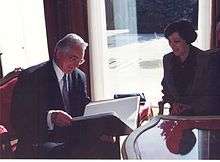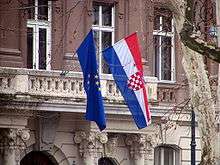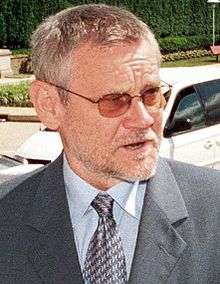History of Croatia since 1995
Part of a series on the |
|---|
| History of Croatia |
 |
|
Contemporary Croatia |
| Timeline |
|
|
This is the history of Croatia since the end of the Croatian War of Independence.
Tuđman: peacetime presidency (1995–1999)

In November 1995 the war in Croatia ended. Around 20,000 people were killed in the war, while official figures on wartime damage published in Croatia in 1996 specify 180,000 destroyed housing units, 25% of the Croatian economy destroyed, and US$27 billion of material damage.[1] Europe Review 2003/04 estimated the war damage at US$37 billion in damaged infrastructure, lost economic output, and refugee-related costs, while GDP dropped 21% in the period.[2] 15 percent of housing units and 2,423 cultural heritage structures, including 495 sacral structures, were destroyed or damaged.[3] The war imposed an additional economic burden of very high military expenditures. By 1994, as Croatia rapidly developed into a de facto war economy, the military consumed as much as 60 percent of total government spending.[4]
Following the end of the war, parliamentary elections were held in 1995, which resulted in a victory of the ruling Croatian Democratic Union. Zlatko Mateša became the new Prime Minister of Croatia, replacing Nikica Valentić, and formed the first peacetime government of independent Croatia. Elections for the Zagreb Assembly were held at the same time, which were won by the opposition. This led to the Zagreb crisis since the president refused to provide formal confirmation to the opposition parties proposed Mayor of Zagreb. In 1996 mass demonstrations were held in Zagreb in response to revoking broadcasting license to Radio 101, a radio station that was critical towards the ruling party.[5]
As a result of the macro-stabilization programs, the negative growth of GDP during the early 1990s stopped and turned into a positive trend. Post-war reconstruction activity provided another impetus to growth. Consumer spending and private sector investments, both of which were postponed during the war, contributed to the growth in 1995-97 and improved economic conditions.[6] Real GDP growth in 1995 was 6,8%, in 1996 5,9% and in 1997 6,6%.[7]
In 1995 a Ministry of Privatization was established with Ivan Penić as its first minister.[8] Privatization in Croatia had barely begun when war broke out in 1991 and its transformation from a planned economy to a market economy was thus slow and unsteady. The ruling party was criticised for transferring enterprises to a group of privileged owners connected to the party.[9]
Croatia became a member of the Council of Europe on 6 November 1996. President of Croatia Franjo Tuđman won the 1997 presidential elections with 61.4% of the votes and was re-elected to a second five-year term. Marina Matulović-Dropulić became the Mayor of Zagreb having won the 1997 local elections, which formally ended the Zagreb crisis.
The remaining part of former Republic of Serbian Krajina, areas adjacent to FR Yugoslavia, negotiated a peaceful reintegration process with the Croatian Government. The so-called Erdut Agreement made the area a temporary protectorate of the United Nations Transitional Administration for Eastern Slavonia, Baranja and Western Sirmium. The area was formally re-integrated into Croatia on 15 January 1998. On 3 October 1998 Pope John Paul II beatified Cardinal Alojzije Stepinac.[10]
Value-added tax was introduced in 1998 and the central government budget was in surplus that year.[11] At the end of 1998 Croatia went into a recession and GDP growth slowed down to 1,9%. The recession continued throughout 1999 when GDP fell by 0,9%.[7] Unemployment increased from around 10% in 1996 and 1997 to 11,4% in 1998. By the end of 1999 it reached 13,6%. The country emerged from the recession in the 4th quarter of 1999.[12]
Račan government (2000–2003)
Tuđman died in 1999 and in the early 2000 parliamentary elections, the nationalist Croatian Democratic Union (HDZ) government was replaced by a center-left coalition, with Ivica Račan as prime minister. At the same time, presidential elections were held which were won by a moderate, Stjepan Mesić.
The new Račan government amended the Constitution, changing the political system from a presidential system to a parliamentary system, transferring most executive presidential powers from the president onto the institutions of the Parliament and the Prime Minister. Nevertheless, the President remained the Commander-in-Chief, and notably used this power in response to the Twelve Generals' Letter.
Economic growth picked up in 2000 following the recession.[12] The new government started several large building projects, including state-sponsored housing and the building of the vital Zagreb-Split Highway, today's A1. Economic growth in the 2000s was stimulated by a credit boom led by newly privatized banks, capital investment, especially in road construction, a rebound in tourism and credit-driven consumer spending. Inflation remained tame and the currency, the kuna, stable.[13][14] The country rebounded from a mild recession in 1998/1999 and achieved notable economic growth during the following years. The unemployment rate would continue to rise until 2001 when it finally started falling. Return of refugees accelerated as many homes were rebuilt by the government; most Croats had already returned (except for some in Vukovar), whereas only a third of the Serbs had done so, impeded by unfavorable property laws as well as ethnic and economic issues.
The Račan government is often credited with bringing Croatia out of semi-isolation of the Tuđman era. Croatia became a World Trade Organization (WTO) member on 30 November 2000. The country signed a Stabilization and Association Agreement (SAA) with the European Union in October 2001, and applied for membership in February/March 2003.
Sanader government (2003–2009)


In late 2003, new parliamentary elections were held and a reformed HDZ party won under leadership of Ivo Sanader, who became prime minister. After some delay caused by controversy over extradition of army generals to the ICTY, in 2004 the European Commission finally issued a recommendation that the accession negotiations with Croatia should begin. Its report on Croatia described it as a modern democratic society with a competent economy and the ability to take on further obligations, provided it continued the reform process.
The country was given EU applicant status on 18 June 2004 and a negotiations framework was set up in March 2005. Actual negotiations began after the capture of general Ante Gotovina in December 2005, which resolved outstanding issues with the ICTY in the Hague. However, numerous complications stalled the negotiating process, most notably during Slovenia's blockade of Croatia's EU accession from December 2008 until September 2009.
In August 2007, Croatia experienced a tragedy when during the fires that ravaged its coast, 12 firemen died as a result of a fire on Kornat island.
Sanader was reelected in the closely contested 2007 parliamentary election.
The October 2008 assassination of Ivo Pukanić was one of several prominent murders in Croatia at the time which were attributed to organized crime and associated by the media with an increased occurrence of crime in Zagreb in 2008.[15] In March 2008, an 18-year-old Bad Blue Boys football fan was killed in the Ribnjak Park, followed by a retaliation by other BBB members.[16] A mob beating at a bus stop in the high-traffic Većeslav Holjevac Avenue ensued, with deadly consequences for 18 year old Luka Ritz.[17] The October 2008 murder of Ivana Hodak, the daughter of Zvonimir Hodak, the lawyer who defended alleged war profiteer general Vladimir Zagorec, caused the Prime Minister Ivo Sanader to fire Marijan Benko, chief of Zagreb Police Department, Berislav Rončević, Minister of Internal Affairs and Ana Lovrin, Minister of Justice. Rončević was replaced by Tomislav Karamarko and Lovrin by Ivan Šimonović.[15][18] In February 2009, the Hodak murder was attributed by the police to a homeless unemployed man blaming Zvonimir Hodak for his problems in life.[19]
In June 2009, Sanader abruptly resigned his post, leaving scarce explanation for his actions, and rumours of involvement in various criminal cases became increasingly rampant.
Kosor government (2009–2011)

Jadranka Kosor assumed the head of the government following Sanader's resignation. Kosor introduced austerity measures to counter the economic crisis and launched an anti-corruption campaign aimed at public officials.
Jadranka Kosor signed an agreement with Borut Pahor, the premier of Slovenia, in November 2009, that ended Slovenia's blockade of Croatia's EU accession and allowed Croatian EU entry negotiations to proceed.
In the first round of the 2010 presidential election the HDZ candidate Andrija Hebrang achieved an embarrassing 12% claiming third place, the lowest result for an HDZ presidential candidate ever. Ivo Josipović, the candidate of the largest opposition party, the Social Democratic Party of Croatia, won a landslide victory in the resulting runoff on 10 January.
Ivo Sanader tried to come back in HDZ in early 2010, but was then ejected, charged for corruption by authorities, and later arrested in Austria.
In June 2010, Kosor proposed loosening the labor law and making it more business friendly, in order to foster economic growth. The proposed new labour law would have set a six-month deadline for hammering out a new collective agreement after the existing one expires. After that, the workers' rights would be subject to separate agreements with individual employers instead.[20] The changing of the labour law was greatly opposed by five trade unions: a petition demanding a referendum gathered 813,016 signatures, far more than the required 449,506 signatures (10 percent of all voters in Croatia), in the first successful popular referendum attempt.[21][22][23]
Opinion polling was done for the prospective referendum: an Ipsos Puls for Nova TV poll of 8 July 2010[24] at a sample of 646 indicated 64% would support the referendum, 15% would be against, and 21% were undecided. CRO Demoskop also polled on the matter on 1 and 2 July[25] at a sample of 1300, and found 88.6% of the polled would support it.
After the Ministry of Administration completed its examination of the signatures, the Croatian Government first hinted that of all submitted signatures, no more than 330 thousand are valid, which would be insufficient for starting a referendum.[26] After a public backlash, they nevertheless passed the signatures on to the Parliament. The government then decided to withdraw the reform proposals on 3 September 2010.[27] The Croatian Parliament could not decide conclusively whether this rendered the referendum proposal moot or not, and instead passed the judgement on to the Constitutional Court of Croatia.[28] The court decided on 20 October 2010 that there was no longer any need to hold the referendum.[29] It ordered the government not to subject any changes to the labor law in the following year.
The government and labour unions later agreed that there would be a different referendum instead, asking the question "Do you agree that a referendum must be called if so requested by 200,000 registered voters, and that the time for the collection of the required number of voters' signatures should be 30 days?". It was planned to be held at the same time as the EU accession referendum,[30] but did not happen.
The 2011 Croatian protests were anti-government street protests in Croatia started on 22 February 2011,[31][32][33] after a call to protest over the Internet, and continued almost daily.[34] The protests brought together diverse political persuasions in response to recent government corruption scandals and worries regarding upcoming EU accession, and called for the resignation of Kosor and early elections. They were met by a violent police reaction and a ban on assembly in front of the Croatian Parliament in Zagreb.[35][36] On 26 February, tens of thousands of protesters met in the Croatian capital Zagreb's Ban Jelačić Square to express their support for indicted Croatian War of Independence veterans and demand for Kosor's government to resign.[37] Several dozen people were injured and arrested as anti-government protests degenerated into clashes with police.[37][38] In the following few weeks the number of protesters rose to some 10,000 people,[39] but later the protests gradually stopped.
On 30 June 2011 the EU accession agreement was concluded, giving Croatia the all-clear to join, with a projected accession date of 1 July 2013.[40]
Milanović government (2011–2016)
The Croatian parliamentary election, 2011 was held on 4 December 2011, and the Kukuriku coalition won. Zoran Milanović became the prime minister of the coalition government.
In January 2012, the new government organized a referendum for EU membership that passed with 66.27%. After the referendum, the Sabor ratified the accession treaty, the Treaty of Accession 2011.
The Milanović cabinet endured a major change when the first deputy prime minister Radimir Čačić resigned in November 2012, having been convicted of vehicular manslaughter in Hungary.[41]
In the Trial of Gotovina et al, following an initial guilty verdict in April 2011, Ante Gotovina and Mladen Markač were ultimately acquitted in November 2012. Mirjan Damaška, a law professor at the University of Yale stated for the occasion that the theory about the "joint criminal enterprise" would have caused historical, political and law complications for Croatia, but that, as a result of the appeal, Croatia's founding has been internationally recognized as legal via its Operation Storm offensive.[42]
Following the successful ratification of its accession treaty in all existing EU member states, Croatia joined the European Union on 1 July 2013.
Shortly after joining the European union a question of extradition of Josip Perković arose. A member of Yugoslavian secret service UDBA, Germany accused Perković of murder of a Croat citizen Stjepan Đureković ( who is suspected to have stolen 200 million dollars from INA petrol company and has subsequently fled to Germany ). At first Croatia was unwilling to extradite Perković under justification that its constitution prohibited it ( all political crimes fall barred after 2002 ). However, when threatened with sanctions in case of non compliance, the parliament quickly voted to change the constitution to allow the extradition. Finally the law is to come into effect on January the first 2014.
On December the first 2013, Croatia held its third referendum since becoming independent. The referendum question was Do you define marriage as a union between a man and a woman, 65% of Croats voted yes. The referendum was organized by the citizen initiative For the family. The catholic church urged people to vote yes, while the government advised citizens to vote no. The referendum has raised much controversy in the media and on social networks.
The sixth presidential election since independence took place in 2014 and 2015, with a first round held on 28 December 2014 between four candidates: the incumbent Ivo Josipović in office since 2010 and supported by the ruling coalition, former foreign minister and NATO official Kolinda Grabar-Kitarović nominated by the opposition HDZ, Živi zid activist Ivan Sinčić and right-wing populist Milan Kujundžić. Josipović and Grabar-Kitarović won the most votes, but fell short of the required 50% + 1 vote needed to win outright and proceeded to the second round held on 11 January 2015. In the second round Kolinda Grabar-Kitarović was elected the first female president of croatia, winning with 50,74% of the vote and receiving 32.509 votes more than Josipović, thus making the latter the first Croatian president not to succeed in being reelected to office and also resulting in the narrowest margin of victory in any presidential election to date in Croatia.
In 2015, after Hungary built a fence along its border with Serbia, over 17000 refugees crossed the border into Croatia. They are seeking an alternative route into the Schengen area, as part of the refugee crisis, with most refugees fleeing the Syrian civil war and Iraq War (2014–present). As the Croatian Prime minister Zoran Milanović stated that Croatia could not become a "refugee camp" and that it had become overwhelmed by the number of refugees entering the country, it was decided that Croatia would stop registering them and that a certain number of refugees be let into Hungary and Slovenia, attempts were made, however, by the authorities of those countries to obstruct the passage of refugees. The refugee crisis and immigration may also, for the first time in Croatia's history, become a subject of political debate during the next Croatian parliamentary election to be held in 2015.
References
- ↑ Darko Zubrinic. "Croatia within ex-Yugoslavia". Croatianhistory.net. Retrieved February 7, 2010.
- ↑ Europe Review (2003), p. 75
- ↑ Maja Sajler Garmaz (December 21, 1991). "Beskrajna obnova od rata" [Endless reconstruction after the war]. Vjesnik (in Croatian). Narodne Novine d.d. Retrieved January 20, 2011.
- ↑ Commonwealth (1999), p. 280
- ↑ "Jedanaest godina nezavisnosti Radija 101" at poslovni.hr
- ↑ Istvan Benczes: Deficit and Debt in Transition: The Political Economy of Public Finances in Central and Eastern Europe, Central European University Press, 2014, p. 203
- 1 2 National Accounts Main Aggregates Database
- ↑ William Bartlett: Europe's Troubled Region: Economic Development, Institutional Reform, and Social Welfare in the Western Balkans, Routledge, 2007, p. 18
- ↑ William Bartlett: Europe's Troubled Region: Economic Development, Institutional Reform, and Social Welfare in the Western Balkans, Routledge, 2007, p. 66
- ↑ Ramet, Sabrina P. (2010). Central and Southeast European Politics Since 1989. Cambridge, England: Cambridge University Press. p. 277. ISBN 978-1-139-48750-4.
- ↑ OECD: Agricultural Policies in Emerging and Transition Economies 1999, p. 43
- 1 2 Istvan Benczes:Deficit and Debt in Transition: The Political Economy of Public Finances in Central and Eastern Europe, Central European University Press, 2014, p. 207
- ↑ International Business Publications: Croatia Investment and Trade Laws and Regulations Handbook, p. 22
- ↑ CIA Factbook - Croatia
- 1 2 "Croatia vows action against crime wave". Reuters. ekathimerini. 2008-10-07. Archived from the original on 26 October 2008. Retrieved 2008-10-23.
- ↑ "Zagreb's Mayor Protects Fans, Punks Panic". Javno.hr. 2008-03-21. Archived from the original on 19 October 2008. Retrieved 2008-10-07.
- ↑ "Suspect Confess to Attacking Luka Ritz". Javno.hr. 2008-10-22. Archived from the original on 26 October 2008. Retrieved 2008-10-23.
- ↑ "Novi ministri Šimonović i Karamarko položili prisegu". Vijesti.net (in Croatian). 2008-10-10. Archived from the original on 13 October 2008. Retrieved 2008-10-23.
- ↑ "Mafia Kills, But So Do Desperate, Jobless People". Javno.hr. 2009-02-06. Retrieved 2009-02-23.
- ↑ Croatian unions collect enough signatures for referendum
- ↑ "Croat unions win right to referendum on labour law". Forexyard.com. 24 June 2010. Retrieved 24 June 2010.
- ↑ "Sindikati objavili: Imamo 720.078 potpisa za referendum!". Jutarnji list (in Croatian). 24 June 2010. Retrieved 24 June 2010.
- ↑ "Za referendum o ZOR-u prikupljeno 813.016 potpisa". vecernji.hr (in Croatian). 1 July 2010. Retrieved 1 July 2010.
- ↑ http://dnevnik.hr/vijesti/hrvatska/eksluzivno-gradzani-ipak-ne-znaju-zasto-su-potpisali-peticiju.html
- ↑ http://www.promocija-plus.com/javno_mnijenje/index_javno_mnijenje.htm
- ↑ Vlada ruši referendum o Zakonu o radu! (Croatian)
- ↑ http://www.setimes.com/cocoon/setimes/xhtml/en_GB/features/setimes/newsbriefs/2010/09/05/nb-07
- ↑ "Sabor: Ustavni sud odlučivat će o referendumu o ZOR-u". Jutarnji list (in Croatian). 2010-09-24. Retrieved 2010-09-25.
- ↑ http://www.setimes.com/cocoon/setimes/xhtml/en_GB/newsbriefs/setimes/newsbriefs/2010/10/20/nb-08
- ↑ http://www.setimes.com/cocoon/setimes/xhtml/en_GB/newsbriefs/setimes/newsbriefs/2010/11/24/nb-11
- ↑ Protest Movement Growing in Croatia, Antiwar.com
- ↑ Croatian protesters demand government resign, msnbc.com
- ↑ Days of Rage in Croatia, Foreign Policy In Focus
- ↑ "Internetom kruži poziv na prosvjed za rušenje Vlade: U utorak u 13 sati na Markovom trgu". Jutarnji List (in Croatian). 20 February 2011. Retrieved 16 March 2011.
- ↑ M. Barukčić (22 February 2011). "Ni ovcama nije lako". H-Alter (in Croatian). Retrieved 16 March 2011.
- ↑ M.K. (24 February 2011). "Suzavac na zagrebačkim ulicama". H-Alter (in Croatian). Retrieved 16 March 2011.
- 1 2 "Braniteljski prosvjed: Više stotina ljudi sa slikama Gotovine i transparentima okupiralo Trg – mJutarnji". Jutarnji.hr. Retrieved 24 April 2012.
- ↑ "Clashes erupt in Croatian anti-government protests". Radio Netherlands Worldwide. ANP/AFP. 26 February 2011. Retrieved 13 April 2014.
- ↑ "1 mali, 2 mala, 10000 malih indijanaca!". MASA (in Croatian). 5 March 2011. Retrieved 6 June 2011.
- ↑ "EUROPA – Press Releases – EU closes accession negotiations with Croatia". Europa (web portal). 30 June 2011. Retrieved 24 April 2012.
- ↑ "U sjeni presude - Sabor potvrdio treću promjenu u Vladi: Žestoki sukob Lesara i Milanovića!". Jutarnji list (in Croatian). 2012-11-16. Retrieved 2012-11-19.
- ↑ Jureško-Kero, Jadranka (16 November 2012). "Damaška: Poručite generalima da sam presretan jer su na slobodi!". Večernji list (in Croatian). Retrieved 16 November 2012.


